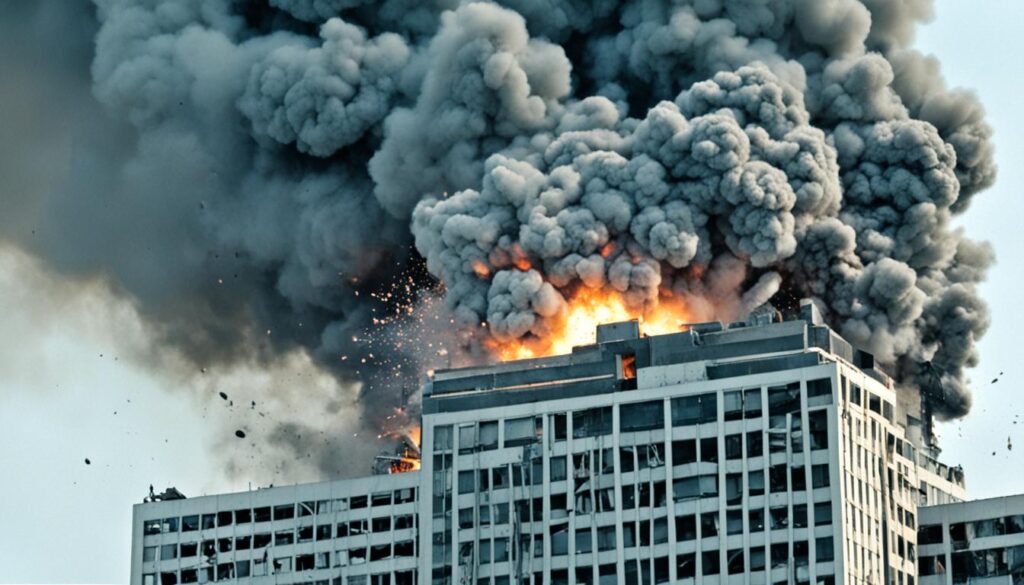Ismail Haniyeh, the leader of Hamas’s political bureau, was killed in Tehran, Iran on July 31, 2024. He was hit by a suspected precision missile strike or AI-guided bombing. This attack happened while he was in a guesthouse, killing him and a bodyguard. It caused little damage to others, showing how precise the operation was.
Key Takeaways
- Ismail Haniyeh, the leader of Hamas’s political bureau, was assassinated in Tehran, Iran on July 31, 2024.
- The attack involved a bomb placed in Haniyeh’s guesthouse room approximately two months in advance and detonated remotely.
- The precision and minimal collateral damage indicate a sophisticated operation, potentially involving a precision missile strike or AI-guided munitions.
- Israel has a history of targeted assassinations of Hamas leaders, including Haniyeh’s deputy in Beirut and the founder of Hamas, Sheikh Ahmed Yasin.
- The absence of a moderate leader like Haniyeh within Hamas could empower more militant factions, leading to increased hostilities against Israel.
Targeted Assassination of Hamas Leader Haniyeh in Tehran
The killing of Hamas’s top leader, Ismail Haniyeh, was a well-planned secret operation. It happened in the early hours of July 31 in Tehran. A bomb was brought into the guesthouse where Haniyeh was staying. It was set off remotely when he was inside. This killed Haniyeh and a bodyguard, with little damage to the area around it.
Covert Operation Eliminates Political Bureau Head
The guesthouse was part of a compound run by the Islamic Revolutionary Guards Corps. It was meant to be very secure. But, there was a big security failure, called a “catastrophic failure of intelligence” by Iranian officials. This showed how good Israel’s intelligence surveillance is at finding and hitting targets that are very careful about security.
Guesthouse Bombing Raises Questions about Tactics
The attack on Haniyeh used a rocket with a seven-kilogram warhead. It caused a lot of damage at the residence. This targeted killing showed a new level of secret action between Israel and Iran. The Hamas leader was killed in Tehran, far from the Gaza conflict area.
| Incident | Details |
|---|---|
| Assassination of Mohsen Fakhrizadeh | In November 2020, a top Iranian military nuclear scientist, Mohsen Fakhrizadeh, was killed by a remote-controlled machine gun outside Tehran. |
| Stuxnet computer virus | The Stuxnet computer virus, believed to be a joint U.S.-Israeli creation, disrupted Iranian centrifuges in 2010. |
| Alleged Israeli attacks against Iran’s nuclear program | Alleged Israeli attacks against Iran’s nuclear program increased significantly in 2020. |
The attack on Haniyeh has made people worried about the growing tensions between Israel and Iran. Iran’s Supreme Leader Ayatollah Ali Khamenei said there will be “harsh punishment” for the Hamas leader’s death. But, Israeli Foreign Minister Israel Katz said Israel doesn’t want a big war. The U.S. Secretary of State Blinken also called for a ceasefire in Gaza.
Precision Missile Strike or AI Device Bombed Haniyeh?
The death of Ismail Haniyeh, a top Hamas leader, sparked questions about the attack’s nature. Some thought it might be a precision missile strike or AI-guided munitions. But, the attack’s details hint at a more secret and complex plan.
Explosive Device Planted Months in Advance
Experts found out the explosive that killed Haniyeh was set up in a Tehran guesthouse two months before the hit. This shows a lot of planning by a skilled group, like Israel’s Mossad. They’re known for such secret missions.
Minimal Collateral Damage Points to Sophisticated Strike
The attack caused little harm to others nearby. This shows it was a very targeted strike. Other leaders in the same guesthouse were not hurt, proving the killers knew exactly where Haniyeh was. This kind of accuracy points to military operations and counterterrorism strategies at a high level.
“The assassination operation was planned outside of Qatar, the usual residence of Hamas leaders, and the explosive device was planted in the apartment where Haniyeh was staying about two months before it was detonated remotely, killing him and his bodyguard.”
This attack is similar to the one that killed Iran’s top nuclear scientist, Mohsen Fakhrizadeh, in 2020. It might have used ai-guided munitions. The careful planning in both cases shows Israel’s smart counterterrorism strategies in the Gaza conflict.
Israel’s Counterterrorism Strategies in Focus
The killing of Ismail Haniyeh in Tehran has made people talk more about Israel’s counterterrorism strategies. It shows how good Mossad is at covert and high-impact missions. This event proves Israel’s bold moves against Hamas leaders, even in other countries, as part of its counterterrorism efforts.
Mossad’s Stealth Capabilities Highlighted
Mossad is known for its stealth capabilities and precision strikes on important targets. The success against Haniyeh in Tehran shows Mossad’s skill in infiltrating guarded places, getting intelligence, and doing targeted killings with little harm to others.

This event shows Israel’s strong focus on national security and its readiness for covert actions against enemies, even abroad. The way they did the Haniyeh operation shows Mossad’s advanced technological skills and intelligence-gathering abilities. These are key in Israel’s fight against terrorist groups like Hamas.
Geopolitical Tensions and Asymmetric Conflicts
The killing of Ismail Haniyeh in Tehran shows how complex the Middle East is. This action, likely done by Israel, could make things worse in the region. It highlights how modern war is changing, with new tech like AI and secret tactics.
For decades, the Middle East has been in a state of tension, especially over Israel and Palestine. The region has seen many violent fights, like the recent one between Israel and Hamas in Gaza. These fights are hard to deal with because one side uses tactics and weapons that are not fair.
Israel is known for its strong military, thanks to its tech and $3.8 billion in U.S. help each year. Its use of advanced tech, like the Iron Dome and Decisive Victory, worries some. They fear these could lead to too much force and harm innocent people.
| Geopolitical Tensions | Middle East Conflicts | Counterterrorism Strategies |
|---|---|---|
| The Israeli military response to the Hamas-led massacre saw more than 1,400 Israelis killed on October 7th. | Israel reportedly eliminated two senior leaders of Iran-backed terrorist groups in less than 24 hours amid escalating tensions. | The IDF’s new operating concept, Decisive Victory, emphasizes multidomain, combined arms operations supported by artificial intelligence and precision firepower. |
| Hezbollah’s attack on July 27 killed 12 civilians in its deadliest attack, raising the risk of further escalation and a potential full-scale war. | An Iranian UAV strike in Tel Aviv on July 19 resulted in one death and ten injuries, highlighting the multi-front conflict involving Iran’s proxies. | The IDF is currently experimenting with the Decisive Victory operating concept under the Tnufa program initiated in 2020. |
As tensions and conflicts in the Middle East change, finding good ways to fight terrorism is key. Leaders need to make tough choices to keep their countries safe without causing more harm. They must find a way to balance these challenges carefully.

“The IDF relies heavily on Israel’s thriving tech sector for its high-tech military capabilities. Analysts have pointed out that a ‘cult of technology’ contributed to the IDF’s poor performance in the 2006 Lebanon War.”
The world is always changing, making it more important to have good ways to fight terrorism. Leaders must be careful in dealing with these issues. They need to keep their countries safe while avoiding more violence and hurting innocent people.
Conclusion
The killing of Ismail Haniyeh, the top leader of Hamas, in a secret attack in Tehran has big effects on the Gaza conflict and the wider Middle East tensions. The attack shows how advanced and precise modern counterterrorism strategies can be. It also shows how new tech is used in asymmetric warfare.
The world is watching how this event will affect the region. This precision strike and the targeted killings of key figures could change the game for national security and geopolitical tensions in the area.
After Haniyeh’s attack, there’s been another Israeli strike in Lebanon that killed a high-ranking Hezbollah leader. This shows the counterterrorism efforts are getting more intense. The world is keeping a close eye on these events. The balance of power and the risk of a big conflict with the U.S. are big concerns.



